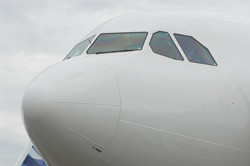Quality assurance for composite materials
The EU-funded project ENCOMB(opens in new window) (Extended non-destructive testing of composite bonds) was launched to address the lack of standardised quality assurance procedures. In particular, non-destructive testing (NDT) technology capable of reliably assessing both composite structures' surfaces and adhesive bonds leads to difficulties in certification. The strength of an adhesive bond depends among other things on the physicochemical properties of the adhered surfaces, adhesive and the joint. The physicochemical properties are affected by a variety of factors, e.g. the degree of contamination, curing parameters, ageing or the activation after surface pre-treatment. Therefore, one of the ENCOMB project objectives was the adaptation of methods for characterisation of adhered surfaces before application of the adhesive. The second challenging goal was the development of techniques for evaluating the bonded components. Scientists defined this newly developed quality assurance technology as extended NDT (ENDT). Firstly, the most representative aeronautic application scenarios were identified. Suitable specimens were developed and characterised using ENDT methods. The results were compared with those of a variety of conventional analytical methods and mechanical testing to evaluate their suitability for the specific measurement tasks. Among others, researchers applied optical methods like laser scanning vibrometry, active thermography and a wetting test to characterise the state of adhered surfaces. Sensor-based techniques such as embedded optical fibre sensors or electrochemical impedance spectroscopy were also tested as well as laser-excited and non-linear ultrasonic techniques. In total, 31 ENDT technologies were tested for the assessment of adhered surfaces and the evaluation of adhesive bonds. In particular, for each of the aeronautic application scenarios, several techniques were applied to detect different contamination levels and passed the validation process. Knowledge gained regarding the effects of bond degradation will guide necessary design improvements. The implementation of reliable assessment technology will lead to an increased use of CFRP components for highly integrated structures. The expected weight savings for the fuselage airframe will be up to 15 %. That will have further effects on the engine size and weight. Overall weight savings will result in significant reductions in fuel consumption and CO2 emissions per passenger-kilometre.







